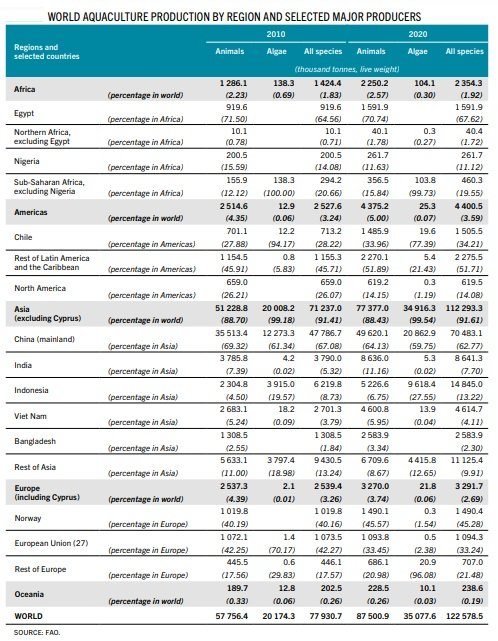Regional breakdown
The FAO states that production of farmed fish is dominated by Asia (89% of the global total in volume terms in the last 20 years). Chile, China and Norway are the top producers in the Americas, Asia and Europe. All three experienced growth in 2020 (SOFIA report, 2022).
The table below shows the global distribution of aquaculture production by region (SOFIA report, 2022):

Species
Carp is the most produced farmed fish species group. Production is expected to decline by 2032, the continuation of a downward trend that started in the late 1990s. Meanwhile the proportion of shrimps and prawns is projected to increase, while the shares of tilapia and salmonids will remain broadly stable (2023 FAO-OECD report).
Aquaculture feed
Fishmeal and fish oil are important ingredients in aquaculture feed. As stated in FAO's 2022 SOFIA report (p77), "fishmeal and fish oil are still considered the most nutritious and most digestible ingredients for farmed fish, as well as the major source of omega-3 fatty acids (eicosapentaenoic acid [EPA] and docosahexaenoic acid [DHA])."
The production of fishmeal is about 5 million tonnes each year. A growing share of fishmeal and fish oil is being produced from fish by-products: "The expansion of processing of fisheries and aquaculture production has resulted in increasing quantities of by-products, which may represent up to 70 percent of processed fish, depending on the size, species and type of processing.[...] Heads, frames, fillet cut-offs, belly flaps and parts of the viscera such as liver and roe are particularly good sources of nutrients such as long-chain omega-3 fatty acids, vitamins A, D and B12, as well as minerals such as iron, zinc, calcium, phosphorus and selenium." (FAO's 2022 SOFIA report, page 79).
According to IFFO, in 2021, 30 percent of the global production of fishmeal and 51 percent of the total production of fish oil were obtained from by-products.
Aquaculture production will be able to expand because of improved efficiency in the use of fishmeal and its specialised uses.
Information on fishmeal and its use in aquaculture can be found in the articles below:








